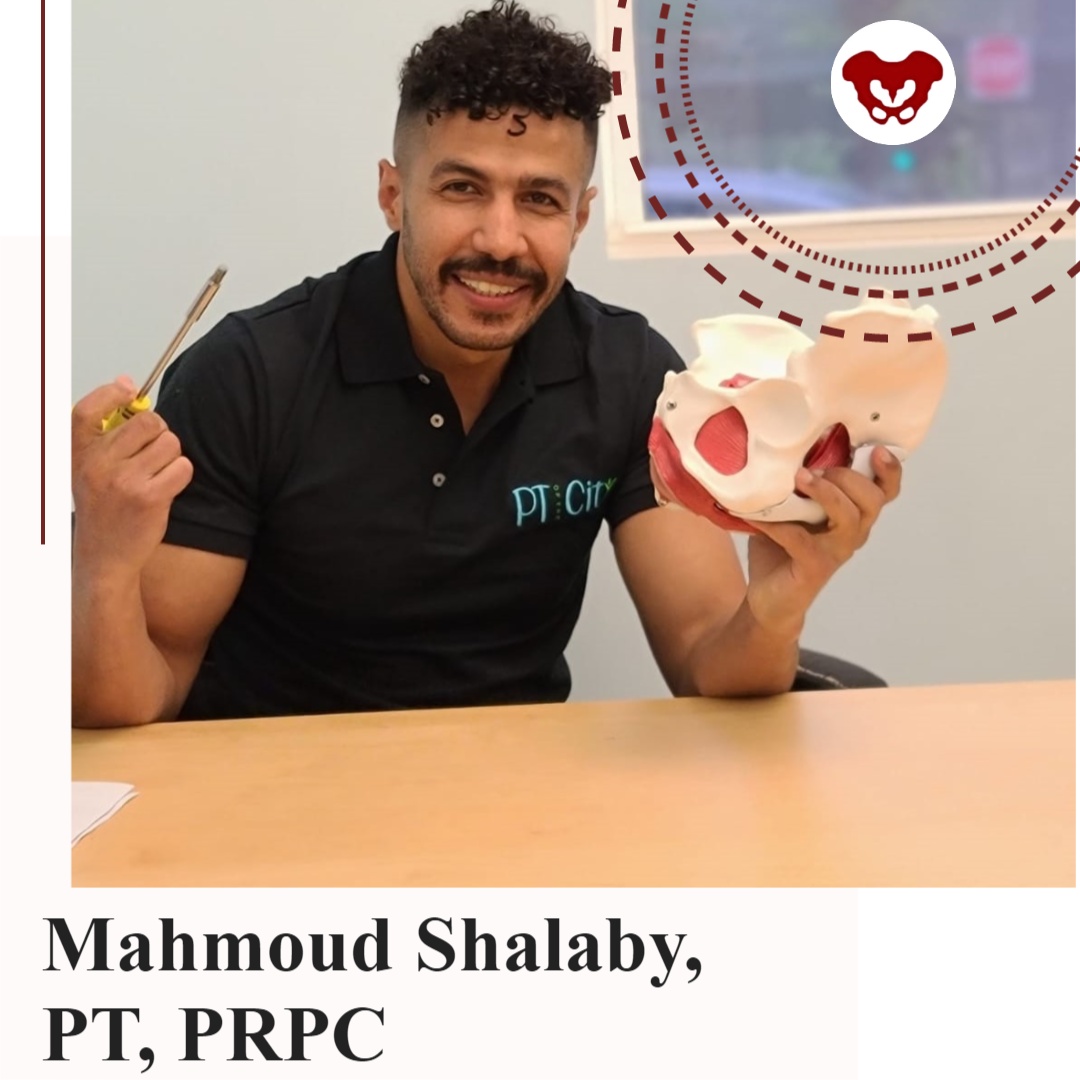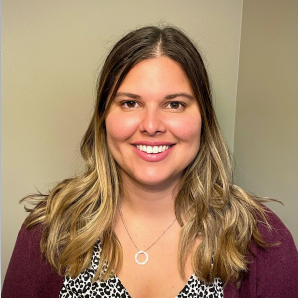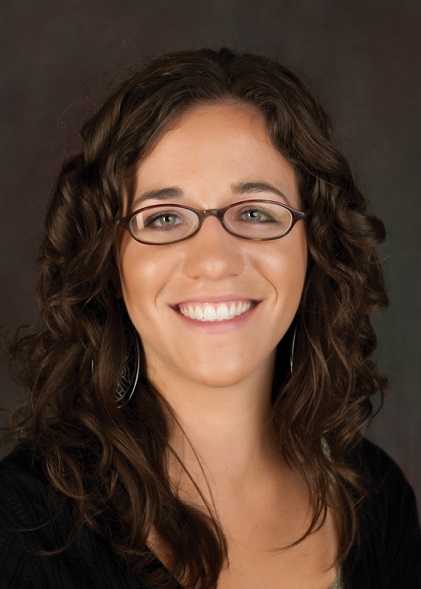
The following is our interview with Mahmoud Shalaby, PT, MS, DPT, PRPC. Mahmoud recently passed the Pelvic Rehabilitation Practitioner Certification (PRPC) exam. He practices at PT of The City in Brooklyn, NY, and is a Teaching Assistant for local New York satellite courses with H&W. Mahmoud was kind enough to share some thoughts about his career with us. Thank you, Mahmoud - and congratulations on receiving your PRPC!
In 2016, I was offered the chance to shadow a senior PT who specialized in pelvic rehab. This specialty was mysterious for me. I didn't think that there was much we could offer to patients with pelvic issues like incontinence, prolapse, IC, and such until I started to treat them. Once I commenced learning more, it never ends.
There is always more to discover and I've always been impressed with the role of physical therapists in assessing and treating pelvic issues. I continue to be very excited to learn more and to develop my experience while further participating in studies to improve my skills and tools in improving people's quality of life.
Herman & Wallace institute has always been my partner in success, they knew how to get me on the track and impressively integrate all resources across body systems to make me confident and skillful to help patients.
When I`ve attended the courses at Herman & Wallace, I have looked at their great Pelvic Rehab certification and immediately I`ve decided to become a certified pelvic rehab specialist for many reasons. To begin with, we must keep high standards to provide such a specific skilled service, in addition to improving my skills, knowledge, and quality to help patients. There are a lot of people suffering from those issues, they either do not know how to address those issues or they do not know where to go.
In particular cultures and religions, the gender of the doctor matters, especially when it comes to sensitive topics, and I am proud to be among the two or three male certified pelvic rehab specialists across the country and I am always happy to get the patients comfortable and confident to be able to address their issues and help them reach their goals.
Working as a teaching assistant at Herman & Wallace is a great opportunity to learn more and explore how newbie therapists think, and help them to see the great skills and tools at this specialty.
As pelvic rehab specialists, we have a great responsibility to raise awareness and educate the community and let them know that we are here for them.

The following is our interview with Jennifer Eller, PT, DPT, PRPC. Jenni recently passed the Pelvic Rehabilitation Practitioner Certification (PRPC) exam. She practices at Enloe Medical Center in Chico, CA and is a Teaching Assistant for local California satellite courses with H&W. Jenni was kind enough to share some thoughts about her career with us. Thank you, Jenni - and congratulations on receiving your PRPC!
Q: Who are you? Describe your clinical practice.
A: My name is Jenni Eller, and I am a pelvic floor physical therapist at Enloe Rehabilitation Center (hospital-based outpatient clinic) in Chico, CA. I specialize in pelvic floor, orthopedic, and oncological diagnoses. Specifically, conditions related to incontinence, pelvic pain, dyspareunia, vaginismus, interstitial cystitis, and the post-surgical pelvis, as well as pelvic floor issues, post-oncological treatment pelvic floor issues, pre and postnatal issues, male pelvic floor dysfunction, and other pelvic floor dysfunctions.
Q: How did you get involved in the pelvic rehabilitation field, and what has your educational journey as a pelvic rehab therapist looked like?
A: I grew up in Oregon and Washington, and completed my undergraduate degree in Exercise Science at Linfield College in 2009. I completed my Doctorate Degree in Physical Therapy at Regis University in Denver, CO in 2013.
After graduate school, I worked in a small rehabilitation hospital but quickly transitioned to outpatient rehabilitation and started working with the orthopedic and oncological patient population. The hospital system I was in had hired 3 new gynecology oncologists and were interested in developing the pelvic health program there. I started my training for pelvic floor physical therapy with Herman and Wallace in 2015. I have completed the Herman and Wallace Pelvic Floor series in 2017 and passed the Pelvic Rehabilitation Practitioner Certification in May 2021.
Q: What patient population do you find most rewarding in treating and why?
A: Over the past 6 years, I have enjoyed helping both women and men with issues related to their pelvic floor, connecting it to their spine, hip, abdominal, and lower extremity issues. I help them return to an active lifestyle and feel empowered over something so limiting and invisible to others.
Patients with pelvic floor dysfunction are often overlooked because their symptoms are too sensitive to speak about. I truly believe they deserve the best care possible and am grateful to be part of a team that focuses on patient-centered care. Treating both pelvic floor dysfunction and the oncological patient population benefits under-served patient populations. Both demographics have my heart for personal reasons. I always knew I wanted to help those who are in need able to get much support.
Q: What has been your favorite Herman & Wallace Course and why?
A: I have enjoyed the whole pelvic floor series, but Pelvic Floor Level 1 and Level 2B, taught by Tina Allen and Holly Tanner, were so great! These courses just inspired me to give my full attention to pelvic health. They are easy to learn from and full of so much knowledge.
Q: What is in store for you in the future as a clinician?
A: Right now, I am focused on building the pelvic health program in this smaller northern California city and hopefully bringing more providers to serve this community. I have a dream of teaching in the future and helping build the next generation of physical therapists and pelvic floor physical therapists.
Adina Leifer, PT, DPT, PRPC recently passed the Pelvic Rehabilitation Practitioner Certification exam and was kind enough to discuss her career with us. Adina Leifer, PT, DPT, PRPC practices at ABLe Pelvic Physical Therapy in Atlanta, GA. Thank you for the interview, Dr. Leifer, and congratulations on earning your certification!
 How did you get involved in the pelvic rehabilitation field?
How did you get involved in the pelvic rehabilitation field?
After graduating from Touro College, and receiving my Doctorate of Physical Therapy. I began to work in an outpatient sports rehab setting. While looking for continuing education courses, I happened upon Herman and Wallace through the Touro College website. They were hosting PF1 at their New York City campus. I knew nothing about pelvic health and rehabilitation at that time. Holly Herman and Tracy Sher taught that first class, after 3 days of class, I was hooked. I knew that pelvic health and wellness was my calling. It has been 9 years since I took that first course and I could not be happier.
What patient population do you find most rewarding in treating and why?
Not sure I can pick one diagnosis or patient population as my favorite. I feel that with each patient that comes to see me, they have either lost ability or do not have normal function of their bladder, bowel or sexual functioning. When I can treat them successfully and educate patients in proper strength and mobility of their pelvic muscles. When I can provide them with the tools so that they can function in their lives, there is nothing more rewarding then that.
Describe your clinical practice:
I currently have my own outpatient practice in Atlanta, GA. I treat adult men and women with any and all pelvic muscle dysfunction and diagnoses.
What has been your favorite Herman & Wallace Course and why?
My favorite course from Herman & Wallace was the capstone course given by Nari Clemons and Jennafer Vande Vegte. I felt this course was informative with practical hands on information for everyday patient treatment. As well as, really helping me to prepare for the PRPC exam.
What motivated you to earn PRPC?
Having practiced for over 9 years and taken many courses through Herman & Wallace, I felt my knowledge and experience made me a specialist. As I was building my own practice, I felt that I wanted the credentials and letters after my name to prove that I was truly a specialist in this field.
What advice would you give to physical therapists interested in earning PRPC?
Go for it! Study the coursework and anatomy. Trust in the knowledge that you have and take the test! You will be very happy that you did.
Certified Pelvic Rehabilitation Practitioners have experience treating a wide variety of pelvic floor dysfunction conditions in men and women throughout the lifecycle. Each certified practitioner has passed a comprehensive exam, and has directly treated pelvic patients for more than 2,000 hours. To learn more about the Pelvic Rehabilitation Practitioner Certification, visit our certification page.
Lee Sowada, PT, DPT, PRPC is a newly minted Certified Pelvic Rehabilitation Practitioner (PRPC) who treats patients in rural Wyoming. Within her community, she relishes the chance to bring pelvic rehab to a more rural environment and provide care that many people in the community didn't know existed. Dr. Sowada was kind enough to share her story with us. Thanks, Lee, and congratulations on earning your certification!
How did you get involved in the pelvic rehabilitation field?
 I fell into pelvic health rehab by accident as a student when I was placed in a “Women’s Health” rotation at the last minute. Initially I was disappointed as this was my last clinical rotation and among the longest. However, I fell in love with this line of work almost right away. It was evident from the start that pelvic rehab makes an enormous impact on a person’s life in a way that most outpatient rehab doesn’t. The impairments were private and sometimes embarrassing and they often resulted in social isolation and loneliness with the inability to share it and the assumption that nothing could be done. It was so rewarding to provide support, information and much needed treatment. After that, I never looked back.
I fell into pelvic health rehab by accident as a student when I was placed in a “Women’s Health” rotation at the last minute. Initially I was disappointed as this was my last clinical rotation and among the longest. However, I fell in love with this line of work almost right away. It was evident from the start that pelvic rehab makes an enormous impact on a person’s life in a way that most outpatient rehab doesn’t. The impairments were private and sometimes embarrassing and they often resulted in social isolation and loneliness with the inability to share it and the assumption that nothing could be done. It was so rewarding to provide support, information and much needed treatment. After that, I never looked back.
What patient population do you find most rewarding in treating and why?
While I’m continually fascinated and challenged by nearly all pelvic rehabilitation, I really love treating pelvic pain. I love the problem solving and detective work with a required knowledge of urology, gynecology and gastro-intestinal health (along with the musculoskeletal system). I always look at the body as a whole and study functional alignment, myofascial restriction, strength and tone asymmetries, and try to connect the patient with the other appropriate health care providers. I work in a rural area with little access to pelvic health and these patients are always so grateful for any help.
What has been your favorite Herman & Wallace course?
I really enjoyed the Capstone course. I was blown away by all the great minds attending and teaching the course. The discussions were extremely beneficial and the material addressed many of the questions that had developed, including thorough education regarding diet, hormones, inflammation and chronic disease processes. It was very helpful and I left all the more inspired to treat complicated patients.
What motivated you to earn PRPC?
I was motivated to earn the Pelvic Rehabilitation Practitioner Certification (PRPC) for a few reasons. First, there were details about the anatomy, physiology and pharmacology that I had to research, even after thousands of patient care hours. I wanted those details to be very accessible to me in treatments. I found that studying always improved my patient care. I was able to deliver information about current research that I’d forgotten along the way. Secondly, I wanted to be the clear choice for my referral sources. I was proud of my knowledge base and experience but, to many of them, nothing separated me from other PTs who dabbled in pelvic health. I wanted my commitment to this line of work to be obvious.
Interested in becoming a certified pelvic rehabilitation practitioner? The next testing window is May 1 - May 15, 2017. Learn more at https://www.hermanwallace.com/pelvic-rehabilitation-practitioner-certification.
On November 15th, 2016 a new class of Pelvic Rehabilitation Practitioner Certification was crowned! Today we get to celebrate with Andrea Wood, PT, DPT, PRPC from New York. Andrea was kind enough to share some of her thoughts on pelvic rehabilitation and what certification means to her. Thank you Andrea, and congratulations on earning your PRPC credential! Describe your clinical practice:
Describe your clinical practice:
I work in an orthopedic clinical practice that has one on one care which I think is valuable. I joined my practice to help offer another view that included pelvic floor knowledge to various patient cases. My coworkers and I collaborate a lot because we both may see things differently, and exchanging ideas is always invaluable for optimal patient outcomes. I really believe the best health care practitioners can admit when they don’t know everything and seek out other viewpoints to learn.
How did you get involved in the pelvic rehabilitation field?
I actually had no idea I originally wanted to do pelvic floor rehab. I was lucky to fall into it right out of graduate school up in Boston at a wonderful place called Marathon Physical Therapy. I found it fascinating how important it was to consider in a lot of patients, especially those presenting with hip, back, or pelvic pain. Two years into working, I found out I had mild congenital hip dysplasia in my left hip and underwent a periacetabular osteotomy to correct it. Going through the rehab on the other side as a patient and having to experience what it means to practice a lot of the principles I teach patients made me excited to continue to help people overcome obstacles. I’m a better physical therapist now because of my personal history. It taught me to always give patients the means to keep moving within their means and not provide only passive treatments. My two physical therapists that helped me through that became my biggest role models on how to approach complicated patient problems.
What patient population do you find most rewarding in treating and why?
I find it most rewarding to work with pelvic pain patients. I like to think of them as a puzzle. With those patients, I’m an orthopedic physical therapist first, because of how much influence other parts of the body can have on the pelvis. I also am a big advocate of collaborative health care with those patients, and when you bring a team of different views together (i.e. medical doctor, physical therapy, nutritionist, and psychologist to name a few) I find I learn something new each time.
If you could get a message out to physical therapists about pelvic rehabilitation what would it be?
It is not just about 3 layers of muscles in your pelvic floor and Kegels. Your pelvis is a center of your body with various biomechanical, vascular, and neurological influences. For example, erectile dysfunction in males can be influenced by pelvic floor muscle dysfunction, cardiovascular health, and psychological or neurological conditions. A woman with painful intercourse could have various contributing factors ranging from a back or hip problem to a dermatological skin issue. I think physical therapists not properly educated on pelvic floor rehab oversimplify it unknowingly.
What has been your favorite Herman & Wallace Course and why?
My favorite Herman & Wallace course was the Pudendal Neuralgia and Nerve Entrapment. That course opened my eyes up to pain science and how much we really don’t know about pain as a medical community.
What lesson have you learned from a Herman & Wallace instructor that has stayed with you?
That the amount of pain a patient may have does not always signify the amount of damage that is present. When patients realize this, they feel a lot more hopeful and in control.
What do you find is the most useful resource for your practice?
I love learning from other physical therapy blogs. Blog About Pelvic Pain by Sara Saunder and Julie Weibe’s blogs are two of my favorites to follow. I lend the book Pelvic Pain Explained to a lot of my patients.
What motivated you to earn PRPC?
I like to challenge myself, and I felt it was a good test to access areas I need improvement in and should study more or seek out further continuing education.
What makes you the proudest to have earned PRPC?
I’m proud to have earned the PRPC because I earned something that I am passionate about. Some people don’t get that blessing.
What advice would you give to physical therapists interested in earning PRPC?
Just being passionate and asking a lot of questions about what I don’t know in clinical practice provided me with best tools to prepare for the exam.
What is in store for you in the future?
Continuing to learn as much as I can. I plan on seeking out some continuing education in areas of physical therapy like neurology or cardiovascular issues that can all still influence the pelvic floor. I think its important to be a well rounded physical therapist.
Danielle is among the latest class of Certified Pelvic Rehabilitation Practitioners! Her experience treating patients and owning Core 3 Physical Therapy prepared her to pass the exam in flying colors. Read her bio here and check out our interview below. Congratulations, Danielle!
 What/who inspired you to become involved in pelvic rehabilitation?
What/who inspired you to become involved in pelvic rehabilitation?
A patient was the first one to inspire me to improve my knowledge and treatment abilities in pelvic rehabilitation. I was working with a postpartum patient, while carrying my first child, and she felt that my guidance had been so helpful in her care that it made me interested learning more about the pelvic floor. Most of my fellow colleagues could discuss my orthopedic questions but I didn’t have any mentors that could offer advice in more advanced pelvic floor cases so I started attending the Herman and Wallace classes. They have been an invaluable at improving my ability to care for patients with pelvic pain which has even improved my treatment of orthopedic patients with low back pain and sacroiliac dysfunction.
What patient population do you find most rewarding in treating and why?
I enjoy working with chronic pelvic pain patients because it's rewarding to be able to bring relief to someone who has been living with pain, limited quality of life or even social anxiety and has not received any benefit with other treatment options. Being able to help this patient population understand the pelvic floor muscles and function as well as providing justification to why they are in pain and then help them progress through various treatment approaches makes my job rewarding.
If you could get a message out to physical therapists about pelvic rehabilitation what would it be?
PT's are uniquely trained to provided internal pelvic floor muscle release. This is something that no other health care professional is licensed or has the schedule/time to perform. This technique can provide relief and feedback to your patients that is possible in no other way. If you do not want to address this region or feel comfortable providing this treatment, find a therapist local to you who has experience with pelvic floor and refer when appropriate. Additionally, we as physical therapists are often the first line of defense in recognizing and educating patients about the ability to address a wide variety of symptoms that they believe is "just a normal part of life". Asking the in-depth questions and providing a multimodal approach to their symptoms is not only a boon to the patient but to our profession.
What lesson have you learned from a Herman & Wallace instructor that has stayed with you?
"Your most valuable tool is your finger." It is rare to treat an orthopedic patient without incorporating any hands on approach and the same holds true for the pelvic floor. With an internal exam you can make your most accurate assessment while providing valuable feedback to the patient.
What makes you the most proud to have earned PRPC?
I think it has helped me gain respect with my fellow health care professionals for my expertise in the area of pelvic floor treatment. It has broadened my knowledge base and provided me a strong guide for furthering my ability to treat patients with pelvic pain and dysfunction.
What is in store for you in the future?
I would like to become involved in research to further evidence based evaluation and treatment of pelvic conditions. I hope to facilitate the effectiveness and value in pelvic floor rehabilitation via physical therapy.
What role do you see pelvic health playing in general well-being?
It should become a staple for all pelvic floor surgeries just like a physical therapy is the staple post total knee surgery. Currently in my region I find it very underutilized despite the research behind our treatment. This is largely due to the general population not being aware of the treatment benefits physical therapy can play in pelvic dysfunction. European countries make it a standard of care in this area and I hope we progress to adopt a similar view of treatment.
Congratulations to Jane Blair Johe, PT, PRPC on becoming one of the newest Certified Pelvic Rehabilitation Practitioners! Read our interview with Blair below.
 Tell us about your clinical practice
Tell us about your clinical practice
I work in a free standing outpatient PT center of a large 4 hospital affiliation. 70% lymphedema 30% pelvic floor rehab.
How did you get involved in the pelvic rehabilitation field?
I was already the lymphedema PT (LANA cert.) when I moved to WV. The women's health PT was moving to another state and asked me to please pick up her bladder incontinence patients.
What patient population do you find most rewarding in treating and why?
I do like pelvic pain clients as I can work with other PT’s on staff to problem solve . Both patients and their doctors are so grateful.
If you could get a message out to physical therapists about pelvic rehabilitation what would it be?
That you cannot ignore a very important group of muscles (PF) whether you are treating backs, hips etc. or pain and weakness or balance issues…. it plays such a vital role in wellbeing. Any of these clients should be questioned about bowel and bladder issues.
What has been your favorite Herman & Wallace Course and why?
I took my first course from them in September and was so impressed (compared to other courses)
What lesson have you learned from a Herman & Wallace instructor that has stayed with you?
the PT pelvic floor assessment. Correct postures , breathing and “safe” effort of bowel movements.
What do you find is the most useful resource for your practice?
MedBridge Courses
What motivated you to earn PRPC?
If I only had one pelvic floor referral, I would like to give the best service possible to that client. My referring MD’s are very happy too.
What makes you the most proud to have earned PRPC?
I thought it was a many faceted subject and combined many aspects of my 45 years of physical therapy practice. It made me feel that I do know my profession that I love.
What advice would you give to physical therapists interested in earning PRPC?
Have a broad back ground in multiple areas of PT then I highly recommend Herman and Wallace courses as the best path.
What is in store for you in the future?
A urologist in town contacted me today to set up referring for pre surgery PT (prostate surgery).
Today we are honored to present our featured Certified Pelvic Rehabilitation Practitioner Jessica Dorrington, PT, MPT, OCS, PRPC, CMPT, CSCS! Jessica was kind enough to answer a few questions about her role in pelvic rehab.
Describe your clinical practice:
Our clinic practice is an outpatient orthopedic private practice. We are committed to making individual results accessible through compassionate therapeutic care. Our practice spans treating men, women and children through a realm of urologic, gynecologic, obstetric, and colorectal conditions- as well as orthopedic conditions.
 How did you get involved in the pelvic rehabilitation field?
How did you get involved in the pelvic rehabilitation field?
Initially, I was an outpatient orthopedic physical therapist. Within the first few months of my career, the clinic I was working at needed someone to just “teach Kegel exercises”. When I realized the impact that you could have on someone’s life, I was immediately drawn to the pelvic rehabilitation field. I saw getting someone even 75 percent improvement was a whole different success than getting a shoulder patient 75 percent better that could now throw their ball to their dog. It was restoring relationships, saving marriages, and giving women the freedom to go do things they could not do before.
What/who inspired you to become involved in pelvic rehabilitation?
My patients inspire me every day. I initially started treating incontinence patients and then gradually added chronic pain patients to my case load. Each patient that achieved such success with pelvic rehabilitation inspired me to wanting to learn more and reach out to more patient’s in need of physical therapy. This led me into treating men and children with pelvic rehabilitation issues. My favorite story that initially started me on my career path was a 95 year old women who came to me for low back pain. I asked her if she had any incontinence. After 4 visits, she removed a pessary (that she had for the past 55 years-since the birth of her last child) and was painfree and fully continent!
What patient population do you find most rewarding in treating and why?
My favorite patients are those that have seen every specialist and have complex histories. Being able to really listen to their story and give them answers in a health care setting that has not found a solution to their condition is such a wonderful experience. Our professional affords us such a great opportunity to really get to know these patients, dive deep into their history and put the puzzle pieces together for them in a way most professions do not have time for in our current medical model.
If you could get a message out to physical therapists about pelvic rehabilitation what would it be?
As I have grown as a practitioner over the years, the biggest message I have is to really listen to each story. Even a simple SI joint dysfunction patient or a seemingly straight forward stress incontinence patient can have subjective and objective information that really points to the root of the issue. We can really serve these patients the best and premier care if we are up to date on our dermatologic, hormonal influences, musculoskeletal system, and are strong orthopedic clinicians.
What has been your favorite Herman & Wallace Course and why?
Michelle Lyons Athlete and the Pelvic Floor course was wonderful. Michelle is a gifted facilitator of education, has so many pearls of valuable resources and tidbits. She also does a wonderful job combining the orthopedic and pelvic floor world together.
What lesson have you learned from a Herman & Wallace instructor that has stayed with you?
Holly has been truly inspirational to me as she is so passionate about her career and passionate about our profession. Her education on hormones really helps me to sort out for patients when I feel there is a hormonal influence.
What do you find is the most useful resource for your practice?
A pelvic model and Adrian Louw’s Explanation of Pain/Neuroscience education has been such a great resource. For most pelvic pain patient’s there is some sort of sensitive nervous system overlie and the way he educates patients has been lifechanging. The other strong resource has been motivational interviewing education. This allows to really guide these patients in a way that assesses their readiness and motivation for change. The other resource is using the rehabilitative ultrasound imaging. Jackie Whittaker has been such a wonderful mentor to me and this resource has revolutionized the way that I treat diastasis patients, local stabilization, and men and pediatric populations.
What motivated you to earn PRPC?
I am doing more speaking engagements to other medical providers and am doing a lot of mentorship. Being in these roles, I feel having credentials to back the clinical experience is really valuable.
What makes you the most proud to have earned PRPC?
I took the exam without studying, largely because I wanted to see if my skills and knowledge was antiquated (being I have been doing pelvic floor therapy x 14 years). I found the test to be really fun and challenging in an exciting way. The case studies were true examples of the complex patients we treat and so I enjoyed the process.
What advice would you give to physical therapists interested in earning PRPC?
My advice would be to really do some great critical reasoning around your current patients. We learn best by our patients and doing a practice of critically thinking and differential diagnosis around your current patients will give a platform for this. I recalled treating several patients during the examination and could picture very similar patient presentations. The other piece I would recommend is reviewing your anatomy and pharmacology.
What is in store for you in the future?
I am continually blessed to be able to lead a wonderful team of therapists at our outpatient private practice. We are launching a labor and delivery program and post-partum evaluations. Educating the medical community at large has been a focus of mine and I would like to continue to do so to get the word out about pelvic floor PT. I have been asked to speak at the United Nations next Spring and will be presenting about Pelvic Floor in relation to Motherhood Maternity. Mentorship to pelvic floor therapists and students also continues to be a focus.
What role do you see pelvic health playing in general well-being?
I strongly feel pelvic health therapists could play a role in every orthopedic patient’s care. We have so many tools to really evaluate patients from a full body spectrum and have the ability to address any lumbopelvic condition with true depth. Having this vital information about their bodies can really empower all individuals to return to what they love to do in an active healthy lifestyle!
This week we end with a fantastic interview with our featured pelvic rehab practitioner. Nancy Suarez, MS, PT, BCB-PMD, PRPC just joined the ranks of the elite Certified Pelvic Rehabilitation Practitioners! Check out our interview below:
 Describe your clinical practice:
Describe your clinical practice:
I work in a private practice specializing in women’s and men’s pelvic floor disorders including bowel and bladder issues, prolapse and sexual dysfunction, prenatal and postpartum rehabilitation, pre and postprostatectomy care, and lumbopelvic pain.
How did you get involved in the pelvic rehabilitation field?
As a physical therapist who regularly took continuing education courses following PT school, I happened to be looking for a course that might give me more knowledge to help some of my geriatric patients improve their urinary incontinence. I took my first Pelvic Floor course given by Hollis Herman and Kathe Wallace in 2000, and immediately began to make a difference in many of my patient’s lives.
What/who inspired you to become involved in pelvic rehabilitation?
Really it was my patients that inspired me to become involved in pelvic floor rehabilitation; I knew embarassingly little about it on my own until my first course! I was very fortunate to have been given the opportunity to join a pelvic floor specialty practice a few years after that first course, and there I honed my skills and began adding more pelvic floor courses to improve my practice.
What patient population do you find most rewarding in treating and why?
It is honestly difficult for me to choose one type of patient that I find MOST rewarding; it is such a privilege to see patients getting better when they may have thought there was no hope. I do find that I love helping middle aged and older women learn about their pelvic floor and learn how to overcome their incontinence, prolapse and pain.
Happy Tuesday! Today we are fortunate enough to hear from Stefanie Foster, who just earned her designation as a Certified Pelvic Rehabilitation Practitioner! Thank you for your time, Stefanie, and congratulations!
Describe your clinical practice:
I have a private practice specializing in pelvic health and related orthopedic conditions. My clinical practice is infused with my training in yoga, pelvic rehab, women’s functional nutrition, orthopedic manual physical therapy, and movement system impairment syndromes.
 How did you get involved in the pelvic rehabilitation field?
How did you get involved in the pelvic rehabilitation field?
I first became curious about the pelvic floor muscles as a consequence of treating orthopedic conditions. No matter what you’re working with in that setting– back pain, hip pain, even shoulder or foot, central stability or the core is of utmost importance. I started to wonder what was going on with the respiratory diaphragm and pelvic floor when we were doing all this abdominal bracing that was (and still is in some circles) all the rage. I arranged a clinical in-service with Susan Steffes to come give us a little overview and talk about how to screen for when someone needed to see a pelvic PT. After that little hour, my interest was piqued and I knew I had to learn more…hence my first H&W class.
What/who inspired you to become involved in pelvic rehabilitation?
It was a gradual inspiration, beginning with Susan. Then, I would have to say Holly and Kathe; my experience in Level 1 forever changed my professional trajectory. As far as the “what”, clinically I am always very attracted to the zebras, the complex conditions, the things that are slipping through the cracks in the medical system, the underserved…and everything about pelvic rehabilitation is that. It’s also a big public health...uh I’ll say opportunity rather than crisis. As a profession, we are doing better, but we still have a long way to go before everyone knows what we can do. Imagine how many people we could help if EVERYONE knew?! It’s really exciting!!
What patient population do you find most rewarding in treating and why?
I love working with patients who come in with a student’s mind. The ones who are curious, ask questions, take notes, and consistently do their homework typically develop a great working relationship with me and have excellent outcomes.
If you could get a message out to physical therapists about pelvic rehabilitation what would it be?
To my former orthopedic-focus-only self and anyone in the same boat, it would be to stop pretending the pelvic floor doesn’t matter in your practice. At the very least, when you’re doing your red flag screen and ask if the patient has had any changes in bowel or bladder, stop downplaying it when the patient mentions they have had some minor leaks or constipation. Refer them to a pelvic rehab specialist! Don’t scare them, just tell them it’s common and there’s pharma-free help out there!
What has been your favorite Herman & Wallace Course and why?
Holly and Kathe taught my Level 1 and it was one of THE BEST courses I’ve ever taken (I’m not just saying that because it’s for their site!). They somehow managed to simultaneously have us rolling on the floor laughing, feeling incredibly supported and comfortable, and leave us ready to walk out the door and treat patients Monday morning. Incredible.
What is in store for you in the future?
More teaching and research. I am passionately curious about several unanswered questions and could keep myself busy the rest of my life investigating and sharing my findings. Right now, the relationship of orthopedic conditions and movement impairments of the hip with pelvic floor-related complaints has mesmerized me!
What role do you see pelvic health playing in general well-being?
If you look at the yoga tradition, the pelvic floor is our base, our ground, our safety, our manifestation into the world… Everything we work with - bladder, bowel, sexual function, birth – is so basic to life on earth! Treatment of these conditions is truly life enhancing! Without the pelvic floor and related structures functioning optimally, it’s challenging to get the rest of the system to function optimally.



















































